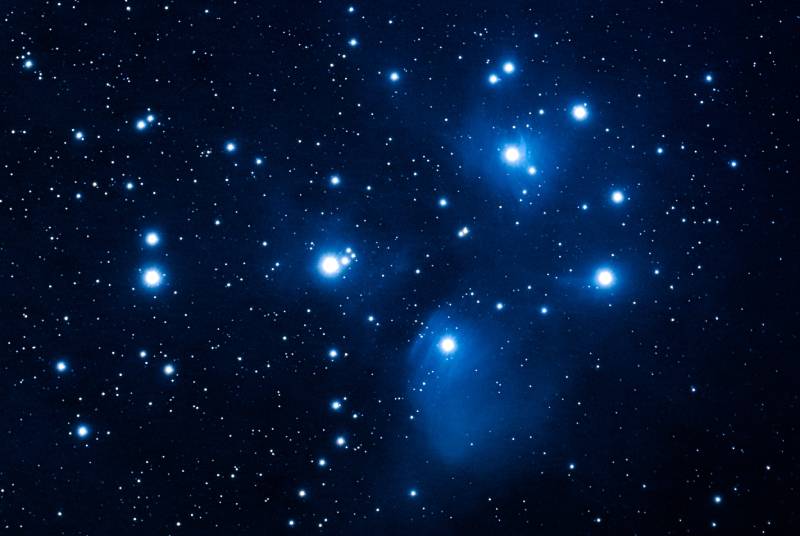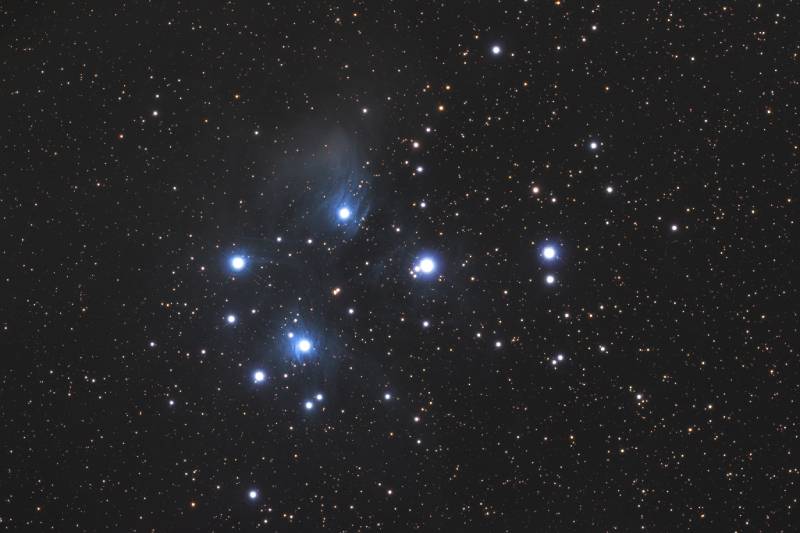11 Interesting Pleiades Star Cluster Facts, Myths & FAQs
Last Updated on

The Pleiades are a cluster of over 800 stars located in the constellation Taurus around 410 light-years from Earth. They are an example of a group of stars born around the same time from an enormous cloud of gas and dust. Pleiades is also well known as the Seven Sisters, which is a name given to it by Greek legends.
The luminous blue constellation formed between 75 and 150 million years ago and is one of the nearest star clusters to the Earth. It is one of the most well-known star clusters in the sky and can easily be seen and identified.

Top 11 Pleiades Star Cluster Facts:
1. The Name Pleiades comes From Ancient Greek

In mythology, the name came from the seven divine sisters and their mother, Pleione. Pleiades effectively means “daughters of Pleione.” The Pleiades cluster’s most distinguishable and brightest stars are named after the Seven Sisters and their parents, totaling nine bright stars.
2. The Pleiades Star Cluster is Visible to The Naked Eye
The brightness of the Pleiades stars varies, and you can see a few or many of them depending on the conditions. In areas with no light pollution, it is possible to catch up to 14 stars with the naked eye. The best time to see the Pleiades is in November because it can be seen the whole night and between October and April. The constellation is best seen in the Northern Hemisphere during winter when Taurus is high in the sky in January and February.
3. Astronomers Estimate That the Pleiades Will Continue to Exist for Another 250 Million Years
The Pleiades open cluster will continue to exist for millions of years. The open cluster has been studied closely and is estimated to live for approximately 250 million years, after which it will disperse due to gravitational interactions.
4. The Pleiades Open Cluster Is Dominated by Hot Blue and Luminous Stars That Formed Between 75 to 150 Million Years Ago.

The Pleiades is an example of an open star cluster, a group of stars that formed simultaneously from a massive cloud of gas and dust. The brightest stars you can see glow a hot blue; although they are bright and luminous, they burn out quickly. When we say quick, we mean a few hundred million years, significantly shorter than the sun’s lifespan.
5. Reflection Nebulae are Present Around the Brightest Pleiades Stars
Reflection nebulae are primarily made up of dust that reflects light from nearby stars and mostly appears blue. Several reflection nebulae surround the brightest Pleiades stars, which may be remnants of the cluster’s formation. Reflection nebulae are visually stunning and are frequently the subject of astrophotography.
6. The Pleiades Core Star Clusters Have a Radius of About Eight Light Years
The apparent size of the Pleiades star cluster is estimated to be around 110 arcminutes. The star cluster contains approximately 800 solar masses, and its whole radius spans about 17.5 lightyears. The core radius of the cluster is approximately 8 light-years, and the tidal radius is approximately 43 light-years.
7. Pleiades Has More Than 1000 Confirmed Stars

Except for unresolved binary stars, the Pleiades open star cluster contains over 1,000 confirmed stars. The open cluster also includes several brown dwarfs, which comprise about 25% of the cluster’s population. Because they typically have less than 8% of the mass of the Sun, they are not heavy enough for nuclear fusion reactions to begin in their cores and form proper stars.
8. Most People Only See Six Stars
Some viewers can see only six stars simply because they all have different brightness levels in their areas, and some stargazers can see fainter stars than others. The ability to see Pleiades stars with the naked eye will depend on your eyesight, atmospheric conditions, and the level of light pollution.
9. Halloween Originates from an Old Druid Rite that Coincided with the Midnight Culmination of the Pleiades Cluster
Many modern Halloween traditions can be traced back to Samhain, a festival of the Ancient Celts and Druids. Samhain occurred on October 31st, during the 11th and 12th centuries when the Pleiades was their highest point in the sky. It was thought that the veil between the living and the dead was thinnest at midnight when the Pleiades reached its culmination.
10. The Pleiades Have been Known to Many Ancient Cultures in the World Throughout Time

The Pleiades have been known to cultures all over the world, including Hawaiians, Arabs, Chinese, Japanese, Celts, Māori, Hindi, Maya, Aztec, Sioux, and Cherokee. The Bible also mentions the Pleiades three times.
11. Galileo Galilei Was the First Astronomer to Use a Telescope to Observe the Pleiades
Galileo Galilei was the first to observe the Pleiades through a telescope and discovered that there were several more stars. They were just too dim to be seen with the naked eye.

Pleiades Mythology
Pleiades is referred to as the Seven Sisters by many cultures around the world. Some stories date back as far as 100,000 years ago.
In Greek mythology, the Pleiades represented the seven daughters of Atlas. Titan was forced to hold up the sky for eternity, and while enduring his punishment, he could not protect his daughters from the likes of Orion.
Orion was confident in his pursuit of the seven sisters because their father was unable to protect them. Artemis sought the help of Zeus, who consequently turned them into stars. As the constellation Orion, Orion still follows the Pleiades across the night sky.
In some versions of the myths, the Pleiades were transformed after committing suicide, which was prompted by news of the deaths of the Hyades and Hyas.
The Pleiades are a group of young girls in many Australian Aboriginal cultures, and they are often associated with sacred women’s ceremonies and stories.

FAQ
What Is So Special About Pleiades?
The Pleiades is one of the closest star clusters to Earth and the most visible cluster to the naked eye in the night sky. It is dominated by hot, luminous stars that give it a glowing blue hue.
How Do I Find Pleiades?
You will start by finding Orion and its two bright leaders, the Betelgeuse and the Rigel. When you find the three stars of Orion’s belt, you will see they point upwards towards the orange-red Aldebaran. Slightly up from there, you will see the Pleiades.

What Is the Blue in the Pleiades?
The blue hue that makes the Pleiades so unique is a blue reflection nebula. This occurs when dust reflects the blue light of young, hot stars. The stars of the Pleiades are also blue, resulting in a more intense luminous blue.
How Can I Photograph Pleiades?
Any camera capable of astrophotography will work fine, but a stock DSRL captures some incredible images. To capture ultra-long exposures of at least 2-minutes or more, use manual mode on your camera and set the camera dial to bulb mode. Longer exposures will begin to reveal the star cluster’s faint outer nebulosity and dust. Use a fast aperture, set your white balance to the daylight setting, and use an ISO of 400-1600 or more.

Conclusion
The Pleiades, famously known as the Seven Sisters, is visible from almost all parts of the globe. The luminous open cluster is a popular target for stargazers, and the familiar and well-known constellation Orion is a sure way to know you have spotted the Pleiades. Many cultures around the world have studied the Pleiades throughout history, and its stars are considered siblings in science and myth.
Featured Image Credit: David Hajnal, Shutterstock
Table of Contents
- Top 11 Pleiades Star Cluster Facts:
- 1. The Name Pleiades comes From Ancient Greek
- 2. The Pleiades Star Cluster is Visible to The Naked Eye
- 3. Astronomers Estimate That the Pleiades Will Continue to Exist for Another 250 Million Years
- 4. The Pleiades Open Cluster Is Dominated by Hot Blue and Luminous Stars That Formed Between 75 to 150 Million Years Ago.
- 5. Reflection Nebulae are Present Around the Brightest Pleiades Stars
- 6. The Pleiades Core Star Clusters Have a Radius of About Eight Light Years
- 7. Pleiades Has More Than 1000 Confirmed Stars
- 8. Most People Only See Six Stars
- 9. Halloween Originates from an Old Druid Rite that Coincided with the Midnight Culmination of the Pleiades Cluster
- 10. The Pleiades Have been Known to Many Ancient Cultures in the World Throughout Time
- 11. Galileo Galilei Was the First Astronomer to Use a Telescope to Observe the Pleiades
- Pleiades Mythology
- FAQ
- Conclusion
About the Author Robert Sparks
Robert’s obsession with all things optical started early in life, when his optician father would bring home prototypes for Robert to play with. Nowadays, Robert is dedicated to helping others find the right optics for their needs. His hobbies include astronomy, astrophysics, and model building. Originally from Newark, NJ, he resides in Santa Fe, New Mexico, where the nighttime skies are filled with glittering stars.
Related Articles:
15 Crucial Facts About Ultraviolet Rays & the Sun
What Constellation Is Spica In? The Interesting Answer!
10 Interesting Leo Constellation Facts, Myths, and FAQs
15 Interesting Pegasus Constellation Facts, Myths, and FAQs
6 Interesting Sagittarius Constellation Facts, Myths, and FAQs in 2024!
What Are Constellations? Where Did They Come From?
8 Interesting Libra Constellation Facts, Myths, and FAQs
What Is Infrared Radiation? Science-Based Facts & FAQ
